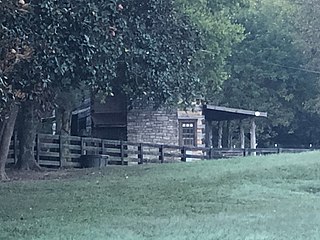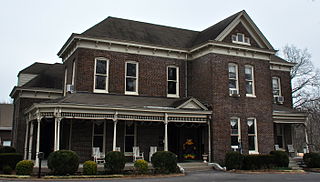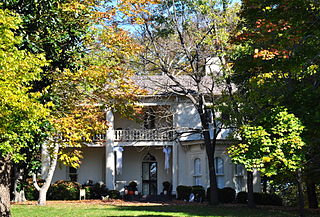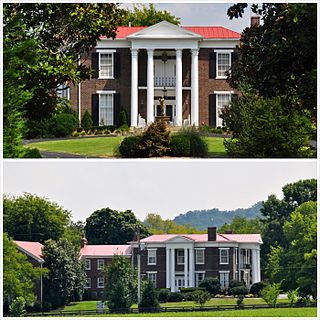
Old Town is an archaeological site in Williamson County, Tennessee near Franklin. The site includes the remnants of a Native American village and mound complex of the Mississippian culture, and is listed on the National Register of Historic Places (NRHP) as Old Town Archaeological Site (40WM2).

The Old Town Bridge in Franklin, Tennessee was a "frame bridge across Brown Creek near its junction with the Big Harpeth River." It was built by U.S. soldiers in 1801. It carried the Harpeth River branch of the Natchez Trace over Brown's Creek. The bridge was rebuilt several times subsequently, but was dismantled some time before 1988. Only the limestone abutments remained when the site was surveyed in 1988.

Old Town, also known as the Thomas Brown House, is a house in Franklin, Tennessee, United States, at the Old Town Archeological Site that was built by Thomas Brown starting in 1846. It is a two-story frame structure built on an "I-House" plan, an example of vernacular architecture showing Greek Revival influences. The Thomas Brown House is among the best two-story vernacular I-house examples in the county.

The William Allison House near College Grove, Tennessee is an antebellum, brick central passage plan house with Federal style detailing built during 1827–1832. It is a two-story house with a two-story rear ell and exterior brick chimneys. It has a one-story shed-roof addition from c. 1860 and a c. 1940 porch.

Boyd Mill Ruins is a property in Franklin, Tennessee that was listed on the National Register of Historic Places in 1988.

The Boyd–Wilson Farm is a 157-acre (64 ha) historic district in Franklin, Tennessee, United States. The circa 1840 farm includes an I-house.

The John M. Winstead Houses, also known as Pleasant Hill, are three antebellum houses in Brentwood, Tennessee that were together listed on the National Register of Historic Places in 1988.

The Henry H. Mayberry House, also known as "Riverview", is a private home in Franklin, Tennessee located on Franklin Pike just north of the Harpeth River Bridge. Built in 1902 in Neo-Classical or Classical Revival architecture, it is one of the notable residences of the 1900-1935 period in Williamson County. At the time it was built it had the most technologically advanced utilities in the county, including electric lights and its own water works. It was listed on the National Register of Historic Places in 1988. When listed, the property included an area of 26 acres (11 ha).

Glen Echo, also known as Harpeth Hall, is a property in Franklin, Tennessee that was listed on the National Register of Historic Places in 1976. It is a former plantation house that is now the centerpiece and administrative office of the Battle Ground Academy campus.

Cox House is a building in Franklin, Tennessee that was listed on the National Register of Historic Places in 1980. It is also known as the Harpeth Academy building.

The Owen-Cox House is a property in Brentwood, Tennessee that was listed on the National Register of Historic Places in 1988. The property is also known as Maplelawn.

The Nicholas Tate Perkins House is a property in Franklin, Tennessee, United States, that was listed on the National Register of Historic Places in 1988. The property is also known as Two Rivers. It was built or has other significance as of c.1820. It includes Central passage plan and other architecture. When listed the property included two contributing buildings and one non-contributing structure, on an area of 3.4 acres (1.4 ha). The property was covered in a 1988 study of Williamson County historical resources.

The Jordan–Williams House is an Italianate style house in Nolensville, Tennessee that was listed on the National Register of Historic Places in 1988.

The Hamilton-Brown House, in Franklin, Tennessee, also known as the Elijah Hamilton House or as Cottonwood, is a historic two-story brick house that was listed on the National Register of Historic Places in 2006.

Thomas Shute House is a property in Franklin, Tennessee, United States, that was listed on the National Register of Historic Places in 1988. The property has also been known as Creekside. It dates from at c.1845. When listed the property included three contributing buildings, and two contributing structures on an area of 4.8 acres (1.9 ha). The property was covered in a 1988 study of Williamson County historical resources. It is one of about thirty "significant brick and frame residences" surviving in Williamson County that were built during 1830 to 1860 and "were the center of large plantations " and display "some of the finest construction of the ante-bellum era." It faces on the Franklin and Columbia Pike that ran south from Brentwood to Franklin to Columbia.

The James Johnston House is a property in Brentwood, Tennessee that dates from c.1840 and that was listed on the National Register of Historic Places in 1976. It has also been known as Isola Bella.

The Owen Chapel Church of Christ is a property in Brentwood, Tennessee that was built c. 1860 and that was listed on the National Register of Historic Places in 1986. It includes Greek Revival and "Vernacular Greek Revival" architecture.

Mooreland is a property in Brentwood, Tennessee that was built c.1838 and that was listed on the National Register of Historic Places in 1975.

Mountview is a property in Brentwood, Tennessee that was built in 1860 and that was listed on the National Register of Historic Places in 1986. It has also been known as the Davis-Rozelle Residence.

Oak Hall is a building and property on Wilson Pike in Brentwood, Tennessee that dates from 1845 and was listed on the National Register of Historic Places in 1986. It has also been known as Century Oak.























